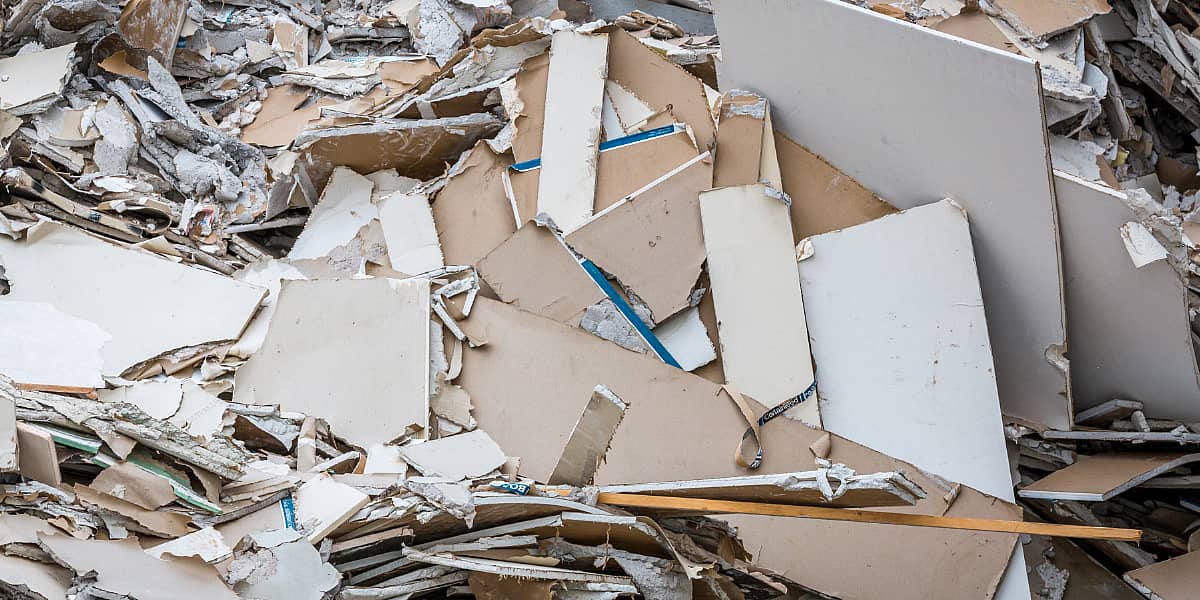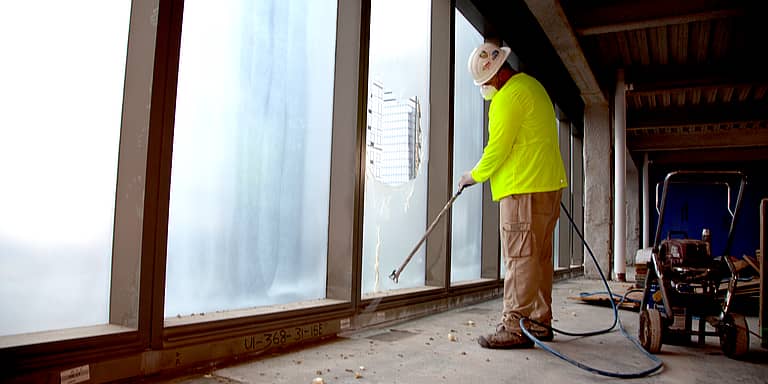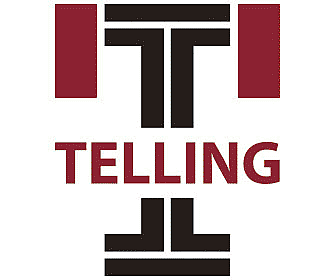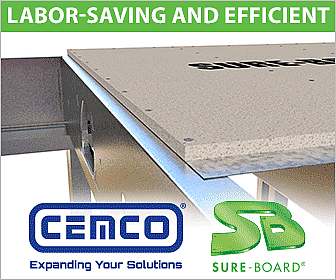Over the last several years interest in recycling construction and demolition (C&D) waste has increased at a steady pace. Version 4 of the Leadership in Energy and Environmental Design (LEED v4) rating system is certainly a contributing factor. When LEED v4 became mandatory on Nov. 1, 2016, for the first time a construction waste management plan was included among the prerequisites necessary to achieve any level of certification. Actual diversion of C&D waste from landfill is necessary only if points are desired. Additionally, under LEED v4 the use of C&D fines for alternative daily cover at landfill sites is no longer considered recycling because it does not reduce materials disposed in landfills.
Now forced to take a long, hard look at the multiple waste streams generated from new construction and the need to build a plan to handle them, project teams are giving more serious consideration to landfill diversion. Turns out, gleaning an additional one or two points from either diverting significant percentages of waste streams or reducing the amount generated on the job site is a good incentive.
Reasons for the Interest
LEED was hardly the only factor spurring interest in recycling C&D waste. Unsurprisingly, state and local governments have played a very active role in discouraging landfilling of bulky construction materials. C&D waste takes up precious space in landfills. The Environmental Protection Agency reports that 230 million to 530 million tons of C&D are produced nationwide each year. To put that in perspective, the Construction and Demolition Recycling Association notes that recycling 583 million tons of C&D waste preserves 4,300 acres of landfill. States and municipalities have taken notice, and currently 13 states and 128 municipalities ban some C&D waste materials. For example, Massachusetts has banned the landfilling of asphalt pavement, brick, concrete, metal and wood. Clean scrap drywall from new construction was added to its banned materials list in 2011.
New construction projects generate a significant amount of clean scrap gypsum board. An estimated 10% to15% of the gypsum board necessary for a new building ends up as scrap. Once the paper facer is removed from gypsum board, the core, which is essentially gypsum, can be recycled as an additive to concrete, plaster, stucco as well as added to new board. The core material also can be used as a soil amendment, and as a water treatment to settle suspended clay particles. Paper remnants can be added to animal bedding to absorb moisture.
Despite all the interest in C&D diversion, the reality is that some building products are more readily diverted, reused or recycled than others. Metals like steel and aluminum have end markets and collection systems readily at hand. In 10 states and the District of Columbia paint manufacturers have supported stewardship laws that boost paint recycling. If buildings are carefully deconstructed, rather than demolished, materials like dimensional lumber can be recovered, refabricated or incorporated into other wood products.
Some C&D materials, including gypsum panels, vinyl siding recycling and flat glass, present greater challenges. Despite the fact that windows are regularly replaced with more efficient fenestration products, according to a recent article in Glass magazine old windows are seldom recycled at end of life. Although most used glass can be sorted, cleaned and broken up to serve as cullet for re-melting into new glass, fiberglass, foam glass and aggregate, a lack of infrastructure prevents this from happening at a high rate. Glass cullet producers are few and far between because a steady stream of uncontaminated glass is not widely available, and glass collection for recycling lags because glass cullet producers are not numerous—a self-reinforcing problem. Similarly, vinyl siding is readily recycled, but getting used siding to processors for conversion to feedstock is challenging due to distances. The Vinyl Institute is piloting a recycled siding project in Ohio because a strong concentration of both manufacturers and recyclers in the state creates a positive and realistic scenario. Successful recycling strategies are often localized and opportunistic.
It’s the Smell
The case for gypsum recycling is not only based on its bulk taking up landfill space or a pressing need to conserve resources for future generations—after all, gypsum is one of the most plentiful minerals on earth. However, gypsum’s chemical composition can lead to the production of hydrogen sulfide gas during natural bacterial decomposition in a landfill setting. Hydrogen sulfide (H2S) gas is colorless, heavy and smells like rotten eggs. Unlike other landfill gasses, H2S does not contribute to global warming and is generally regulated as a nuisance gas. While gypsum isn’t the only material contributing to hydrogen sulfide gas at landfills, landfilling of gypsum panels is associated with higher levels of H2S. Exposure to even low levels can cause irritability, watery eyes, asthmatic symptoms and headaches. Reducing the landfilling of gypsum wallboard reduces the generation of H2S.
Preserving landfill capacity, preventing H2S gas formation, and a desire on the part of green builders to realize a circular economy are the main catalysts for gypsum panel recycling today. Gypsum industry efforts to increase recycling by incorporating scrap from new construction is ongoing. Gypsum Association members are interested in and supportive of recycling and would welcome more widespread availability of recycled gypsum feedstock. As is the case with flat gas, processors are scarce.
Challenges, Concerns and Caveats
Obviously, gypsum panel recycling presents many of the same infrastructure challenges as glass and vinyl recycling, but additional concerns and caveats also exist and must be borne in mind. At this time, gypsum panel manufacturers are leery of demolition gypsum feedstock. Concerns about contamination with lead and asbestos due to the pre-1978 application of lead-based paint and previous use of asbestos in joint compounds makes demolition material a safety risk. Moreover, the Drywall Safety Act of 2012, in which Congress directed the Consumer Product Safety Commission to promulgate a final rule to combat the issue of high sulfur content in imported Chinese drywall, required CPSC to “specify that problematic drywall … should not be reused or used as a component in production of new drywall.”
Contamination is also a concern for gypsum recyclers. A recent article in American Recycler discussed the turmoil that resulted when asbestos was discovered at a recycling facility in Canada that accepts demolition gypsum. Although the problem was due to bad actors elsewhere in the recycling chain, the incident underscores the reality of potential contamination of demolition material during use.
Because of these concerns, recycling clean scrap cut-offs from new construction represents the best scenario for recycling given existing end markets. Plenty of clean scrap is generated but it must remain clean in order for it to be successfully recovered for open- or closed-loop recycling. Also, gypsum panels break up easily when not attached to framing or properly stored. The inherent rigidity of gypsum panels is an advantage when scoring and snapping for installation, but a disadvantage when scrap is captured for recycling.
To optimized recoverability, ideally these cut-offs are source separated on the job site to prevent cross-contamination with other materials and sent directly to processors. The processors remove the paper facers and create recycled gypsum feedstock for closed-loop recycling in drywall and open-loop recycling into agriculture, portland cement production or another end market.
Movement from place to place, pile to pile or container to container causes breakage, creates gypsum fines and when mixed with other materials increases the possibility of both scrap contamination and cross-contamination of other materials with gypsum. (Fines are the tiny bits that crumble when gypsum board is mishandled and breaks down. C&D fines are all the tiny pieces that break off, and they invariably contain lots of gypsum fines in addition to bits of other materials like wood and metal—a real recycling problem.) Unless clean scrap is source separated at the job site and placed in a dedicated container for processing, the recovery rate tends to be low. Moreover, mixed C&D loads lower the recovery rate across multiple waste streams.
The low recovery rate associated with mixed C&D loads is clear in Massachusetts. The Massachusetts Department of the Environment (MassDEP) recently released a bulky trash waste characterization study that revealed these smaller loads contain numerous materials that could have been recovered had they been removed from the stream earlier. According to a 2016 MassDEP Construction and Demolition Market Study, only 61 tons of clean scrap gypsum received at material recovery facilities was source separated. As a result, of the 22,920 tons of scrap collected, only 811 tons were recycled—a 4% recovery rate. Also noted in the report, most of that clean scrap was recycled in a Pennsylvania facility more than 350 miles away from the most populous city of Boston—an additional environmental impact created by the lack of a processor in Massachusetts.
Calls to the Gypsum Association about recycling have increased over the past few years. Of the two to three calls received each year, most come from construction companies asking where they can take clean scrap for recovery. Some already have source separated the clean scrap—a wonderful development given the lack of guidance documents to educate on the importance of source separation on the job site. At this point, the GA doesn’t keep a list of processors willing to accept clean. Even if we did, such a list would be a very short indeed.
Bright Future for Drywall Contractors
Clearly, gypsum recycling is in its infancy in the United States. Moving forward, drywall contractors will increasingly find themselves at the nexus of construction project managers anxious to recycle and recyclers, haulers and processors seeking to derive the greatest value from collected clean scrap. After all, recyclers and processors are business people, too. Most guidance documents created, such as ASTM C1881, Standard Guide for Closed-Loop Recycling of Scrap Gypsum Panel Products, and CDRA’s Standard Specification for the Production of Recycled Gypsum from Scrap Gypsum Drywall are aimed at processors interested in producing recycled gypsum acceptable for use in either agriculture or as a recycled feedstock for gypsum panel manufacturers.
But separation of drywall for optimal recovery at a material recovery facilities is not the best-case scenario. The best positioned workers to source separate gypsum wallboard are the drywall contractors who generate clean scrap during installation. Think of this not as an additional burden, but rather as potential for increased revenue. DTG Recyclers, a successful recovering and processing company in Washington, offers “concierge” drywall scrapping services for a fee based on a per-foot price. Contractors could do the same.
Another potential revenue stream that drywall contractors might consider is deconstruction. Properly deconstructing a structure—rather than demolishing it—is best done by individuals who understand how building systems are put together in the first place. Paul MacDonald of Ethical Waste Services in Vancouver, British Columbia, sees construction and deconstruction as two sides of the same coin. A 34-year veteran of the construction industry, he worked as a drywall hanger before starting his deconstruction business.
“You almost have to know how it was constructed to safely deconstruct a building,” he says, citing dangers including inadvertently bringing down a load-bearing wall or opening up a cavity that contains asbestos insulation. Even if existing drywall is not acceptable for closed-loop recycling now, many other materials benefit from a deconstruction approach, including wood and metal framing, doors, light fixtures, plumbing fixtures, etc.
Recycling of C&D waste is far more robust in Canada than in the United States. In Vancouver, for example, no house built before 1904 can be demolished. Older homes must be deconstructed for diversion or recycling. Given the direction many state and local governments in the United States are taking when it comes to recycling generally and recycling C&D materials specifically, a future that includes recycling is practically inevitable. It time to start thinking about how you or your company will respond when that future arrives.
Susan Hines, a LEED Green Associate, is director of stewardship and external affairs for the Gypsum Association.








